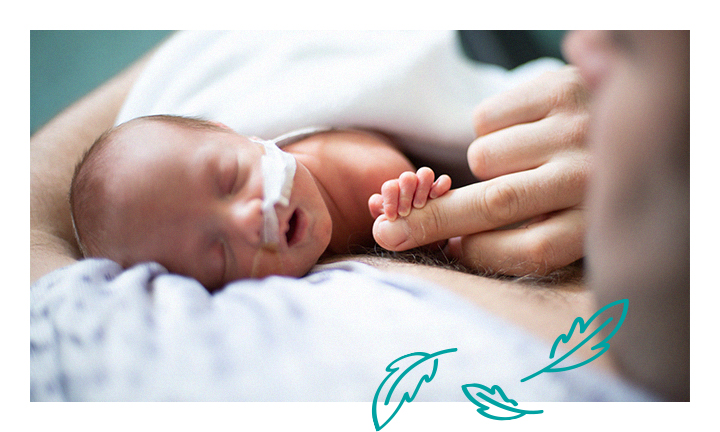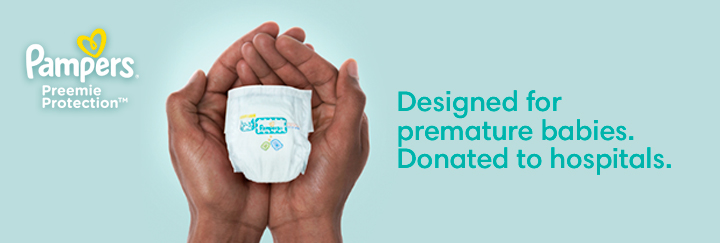
Every Touch is Huge for Premature Babies
Curled up inside the safety of the womb, your baby has already developed a sense of touch, experiencing, learning about and reacting to their environment.¹,² Touch is the earliest of the senses to develop, beginning at just eight weeks and continuing until around 32 weeks, when most of the body is sensitive to the touch of a feather³.
Experiencing the world through touch continues as soon as your baby is born. Through their skin, every newborn will learn about the world around them and begin to experience love, bonding and connection. Premature babies are particularly sensitive to touch,¹ especially as their fragile skin isn’t yet fully formed. And for your tiny baby, who needs a bit of extra care to thrive and grow, every gentle touch is important.
Even though parents know the importance of touch, it can be hard to know how best to comfort and connect with your premature baby, working around all the equipment in the neo-natal intensive unit (NICU). In this article, we explore why touch is so important and the different ways you can use gentle touch to bond with your baby, both in the NICU and at home as you begin to introduce your little one to their new surroundings.
The importance of touch
From the moment your baby is born, they are ready to use their most enhanced and powerful sense to bond with you. Whenever babies, including preterms, receive gentle touch, oxytocin (the love hormone) surges, both in the baby and in their mother or father,⁴ and this helps to develop those deep feelings of attachment⁵ and love.
When your little one is born a little too soon, they spend early moments of their life in the NICU – the best place to help them grow and develop. Still, the NICU environment, with its equipment and essential, life-saving medical interventions, can prevent you having lots of comforting touch time, which we know is important for bonding³,⁴ and development. ⁶, ⁷, ⁸, ⁹
Although it's important to have as much time as possible gently holding and touching your baby in the early weeks of their life, you probably won’t be able to hold your preemie baby as much as you would like. Be guided by the health professionals taking care of your little one and do as much as you can. Every little touch is a step on the journey to forming that all important parent-baby bond.
Practical ways to use touch to comfort and bond with your premature baby
Kangaroo care
Kangaroo care is a special way of caring for your newborn. This is a type of skin-to-skin contact where your baby’s skin rests against yours as they are held close to your chest. Not only does your baby feel you close against them, but they can hear your heartbeat, sense your chest as it expands and smell your special scent. Skin-to-skin contact is important for all babies, but especially for premature babies as it helps the tiniest babies thrive, grow and develop.
Skin-to-skin contact:
Comfort holding
Sometimes it isn’t possible to pick up your baby and hold them, especially if your baby is very premature as their developing skin is often too delicate. In this case, and during life-saving medical interventions, your baby may be more comfortable lying in their incubator. But don’t worry, comfort holding is a great way to soothe and bond with your baby.
Since stroking can be irritating or even painful for very premature babies, comfort holding gives babies the benefits of touch in a different way. To comfort hold your baby, simply cup their head or feet with one hand and then gently rest your other hand across their shoulders or hold their arms against their chest. This is a secure yet gentle hold and allows your baby to feel your warmth and your relaxed and calming touch.
This special form of touch can¹⁰:
Nappy changing
Remember, not all touch needs to be cuddles, every little touch has meaning and every nappy change is a perfect opportunity for parents to bond with their tiny newborn. In our recent survey, almost a third of parents of preterm babies said that changing their baby’s nappy was just as important as touching their baby, when it came to bonding.¹¹
Every caring or feeding opportunity is another chance to strengthen your bond through touch and there are likely to be more chances for these connections than you realise.
Delicate skin needs delicate care
From the moment a baby is born, their skin helps to protect them from the world around them and it even helps to regulate body temperature.¹² But a premature baby’s skin is up to two times thinner than a full-term baby’s skin¹³ so it needs a little more time¹⁴ and care to develop fully..
That’s why we created our specially designed Pampers Preemie Protection nappies (read the full story here) They are crafted to fit preemie babies, designed to wrap gently around your little one and provide the ultimate softness against your baby’s developing skin. The absorb-away liner quickly pulls away wetness and mess, helping to protect against leaks, and the breathable layers allow air to travel in to let the skin breathe.
Friends and families of babies born prematurely can now order their Pampers Preemie Protection Nappies online for free home delivery via www.pampers.co.uk/. Pampers also continue to donate Pampers Preemie Protection nappies direct to hospitals, and via ASDA pharmacies (in-store only and subject to availability)
A continuing journey of bonding through touch
As you spend time getting to know your new baby, responding to their little cues and starting to see their personalities form, touch will be a continuing part of your bonding journey.
You might not be able to hold your premature baby for long, or in the way that you feel you should, but be reassured that every little contact helps you develop more and more of a bond. You are uniquely placed to help your baby develop in these critical weeks; your touch will help reduce their pain, help them gain weight, settle to sleep and so much more.⁶, ⁷, ⁸, ⁹
Whether it’s through kangaroo care, comfort holding, a gentle cuddle before sleep, or simply a nappy change, every little touch counts.
Read more about Prematurity
Related Articles
Join Pampers Club and get:










